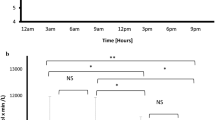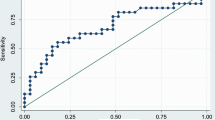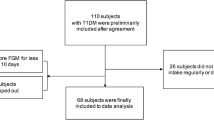Abstract
Aim
To understand the association between macronutrient composition of a diet with Time in Range (TIR), Time above Range (TAR) and Time below Range (TBR) derived using a Continuous Glucose Monitoring (CGM) device for 14 days.
Methodology
An exploratory analysis on the baseline data of 50 Type 2 Diabetes Mellitus participants with age 25–55 years, HbA1c upto 8% and on Metformin only) enrolled for an interventional clinical trial was performed.
Results
Participants consuming adequate carbohydrates (CHO) of 55 to 60% of total calories had better Average Blood Glucose of 142.0 ± 24.0 mg/dL with a significance of p = 0.03 and Glucose Management Indicator (GMI) of 6.6 ± 0.7% significant at p = 0.01, than those with high CHO intake >60% of the total calories, with Average Blood Glucose - 155.0 ± 13.4 mg/dL and GMI - 7.06 ± 0.4%. Similarly, TIR - 68.2 ± 5.1% and TAR - 23.0 ± 10.8% was significantly better (p = 0.00) among those consuming adequate protein (12–15%) as compared to low protein (≤ 10%) with TIR- 61.0 ± 5.1% & TAR- 32.9 ± 10.3%. A correlation (r = −0.482 & p = 0.00) and simple linear regression analysis (R² = 0.33, F = 7.72, p = 0.000) revealed that when CHO intake increases the TIR decreases whereas TAR increases (r = 0.380 & p = 0.006). We did not find any significant relation between fat intake and TIR, TAR or TBR.
Conclusion
Our results suggest that lowering CHO, while increasing protein in the diet may help improve TIR. Further in-depth studies are needed to confirm these findings.

Similar content being viewed by others
References
A.B. Evert, M. Dennison, C.D. Gardner, W.T. Garvey, K.H.K. Lau, J. MacLeod et al. Nutrition Therapy for Adults With Diabetes or Prediabetes: A Consensus Report. Diabetes Care 1 42(5), 731–754 (2019). https://doi.org/10.2337/dci19-0014
E. Koloverou, D.B. Panagiotakos, Macronutrient Composition and Management of Non-Insulin-Dependent Diabetes Mellitus (NIDDM): A New Paradigm for Individualized Nutritional Therapy in Diabetes Patients. Rev. Diabet. Stud. 13(1), 6–16 (2016). https://doi.org/10.1900/RDS.2016.13.6
R.M. Anjana, S. Srinivasan, V. Sudha, S.R. Joshi, B. Saboo, N. Tandon et al. For the ICMR-INDIAB Collaborative Study Group; Macronutrient Recommendations for Remission and Prevention of Diabetes in Asian Indians Based on a Data-Driven Optimization Model: The ICMR-INDIAB National Study. Diabetes Care 45(12), 2883–2891 (2022). https://doi.org/10.2337/dc22-0627
A. Advani, Positioning time in range in diabetes management. Diabetologia 63(2), 242–252 (2020). https://doi.org/10.1007/s00125-019-05027-0
A.E. Nuha, A. Grazia, R.A. Vanita, R.R. Bannuru, F.M. Brown, D. Bruemmer et al. on behalf of the American Diabetes Association, 6. Glycemic Targets: Standards of Care in Diabetes—2023. Diabetes Care 46(Supplement_1), S97–S110 (2023). https://doi.org/10.2337/dc23-S006
A.E. Breyton, S. Lambert-Porcheron, M. Laville, S. Vinoy, J.A. Nazare, CGMS and Glycemic Variability, Relevance in Clinical Research to Evaluate Interventions in T2D, a Literature Review. Front. Endocrinol. 12, 666008 (2021). https://doi.org/10.3389/fendo.2021.666008
J. Merino, I. Linenberg, K.M. Bermingham, S. Ganesh, E. Bakker, L.M. Delahanty et al. Validity of continuous glucose monitoring for categorizing glycemic responses to diet: implications for use in personalized nutrition. Am. J. Clin. Nutr. 115(6), 1569–1576 (2022). https://doi.org/10.1093/ajcn/nqac026
Indian Council of Medical Research|Government of India. (2023). https://main.icmr.nic.in/sites/default/files/guidelines/ICMR_GuidelinesType2diabetes2018_0.pdf
N.A. ElSayed, G. Aleppo, V.R. Aroda, R.R. Bannuru, F.M. Brown, D. Bruemmer et al. American Diabetes Association. 7. Diabetes technology: Standards of Care in Diabetes—2023. Diabetes Care 46(1), S111–S127 (2023). https://doi.org/10.2337/dc23-SDIS
S.R. Joshi, Glycemic Variability and Ambulatory Glucose Profile in Indian Diabetics. J. Assoc. Phys. India 64(4), 11–14 (2016)
American Diabetes Association, 5. Lifestyle Management: Standards of Medical Care in Diabetes—2019. Diabetes Care 42(Supplement_1), S46–S60 (2019). https://doi.org/10.2337/dc19-S005
K. Osugi, Y. Kusunoki, M. Ohigashi, K. Kusunoki, C. Inoue, M. Inoue et al. Association between low‐carbohydrate diets and continuous glucose monitoring‐derived time in ranges. J. Diabetes Investig. 14(5), 659–668 (2023). https://doi.org/10.1111/jdi.13999
A.D. Monzon, L.B. Smith, S.W. Powers, L.M. Dolan, S.R. Patton, The Association Between Glycemic Variability and Macronutrients in Young Children with T1D. J. Pediatr. Psychol. 45(7), 749–758 (2020). https://doi.org/10.1093/jpepsy/jsaa046
Y.H. Lin, Y.Y. Huang, H.Y. Chen, S.H. Hsieh, J.H. Sun, S.T. Chen et al. Impact of Carbohydrate on Glucose Variability in Patients with Type 1 Diabetes Assessed Through Professional Continuous Glucose Monitoring: A Retrospective Study. Diabetes Ther. 10(6), 2289–2304 (2019). https://doi.org/10.1007/s13300-019-00707-x
S.G. Camps, B. Kaur, J. Lim, Y.T. Loo, E. Pang, T. Ng et al. Improved Glycemic Control and Variability: Application of HealthyIngredients in Asian Staples. Nutrients 13, 3102 (2021). https://doi.org/10.3390/nu13093102
L. Rasmussen, M.L. Christensen, C.W. Poulsen, C. Rud, A.S. Christensen, J.R. Andersen et al. Effect of High Versus Low Carbohydrate Intake in the Morning on Glycemic Variability and Glycemic Control Measured by Continuous Blood Glucose Monitoring in Women with Gestational Diabetes Mellitus-A Randomized Crossover Study. Nutrients 12(2), 475 (2020). https://doi.org/10.3390/nu12020475
N.F. Sheard, N.G. Clark, J.C. Brand-Miller, M.J. Franz, F.X. Pi-Sunyer, E. Mayer-Davis et al. Dietary carbohydrate (amount and type) in the prevention and management of diabetes: a statement by the American Diabetes Association. Diabetes Care. 27(9), 2266–2271 (2004). https://doi.org/10.2337/diacare.27.9.2266
B.L. Luhovyy, P. Kathirvel, Food proteins in the regulation of blood glucose control. Adv. Food Nutr. Res 102, 181–231 (2022). https://doi.org/10.1016/bs.afnr.2022.05.001
F. Tettamanzi, V. Bagnardi, P. Louca, A. Nogal, G.S. Monti, S.P. Mambrini et al. A High Protein Diet Is More Effective in Improving Insulin Resistance and Glycemic Variability Compared to a Mediterranean Diet—A Cross-OverControlled Inpatient Dietary Study. Nutrients 13, 4380 (2021). https://doi.org/10.3390/nu13124380
F.R. Muntis, A.E. Smith-Ryan, J. Crandell, K.R. Evenson, D.M. Maahs, M. Seid et al. A High Protein Diet Is Associated with Improved Glycemic Control Following Exercise among Adolescents with Type 1 Diabetes. Nutrients 15(8), 1981 (2023). https://doi.org/10.3390/nu15081981
S.H. Park, J. Yao, X.H. Chua, S.R. Chandran, D.S.L. Gardner, C.M. Khoo et al. Diet and Physical Activity as Determinants of Continuously Measured Glucose Levels in Persons at High Risk of Type 2 Diabetes. Nutrients 14, 366 (2022). https://doi.org/10.3390/nu14020366
Acknowledgements
We acknowledge RSSDI for supporting our study.
Author contributions
Author 1: Conceptualization (equal); Formal Analysis (equal); Investigation (lead); Methodology, Software, and writing – original draft, review, and editing (equal). Author 2: Conceptualization (equal); Formal Analysis (equal); Investigation (supporting); Methodology, Software, and writing – original draft, review, and editing (equal).
Funding
This study is supported by grants from the Research Society for the Study of Diabetes in India (RSSDI).
Author information
Authors and Affiliations
Corresponding author
Ethics declarations
Conflict of interest
The authors declare no competing interests.
Consent to participate
Informed consent was obtained from all subjects participating in the study.
Consent to publish
Informed consent was obtained from all subjects participating in the study for publishing their data.
Ethical approval
The data presented here are from an ongoing crossover clinical trial. The study is ethically approved by the Institutional Ethics Committee of Symbiosis International (Deemed College) (IEC-SIU Pune). The ethics approval number is IEC/SIU/325. The trial is also registered prospectively with Clinical Trials Registry- India. The Trial Registration No. is CTRI/2022/07/044356. This study was conducted in accordance with the tenets of the Declaration of Helsinki.
Additional information
Publisher’s note Springer Nature remains neutral with regard to jurisdictional claims in published maps and institutional affiliations.
Rights and permissions
Springer Nature or its licensor (e.g. a society or other partner) holds exclusive rights to this article under a publishing agreement with the author(s) or other rightsholder(s); author self-archiving of the accepted manuscript version of this article is solely governed by the terms of such publishing agreement and applicable law.
About this article
Cite this article
Deshmane, A.R., Muley, A.S. Dietary composition and time in range in population with type 2 diabetes mellitus-exploring the association using continuous glucose monitoring device. Endocrine (2024). https://doi.org/10.1007/s12020-024-03787-3
Received:
Accepted:
Published:
DOI: https://doi.org/10.1007/s12020-024-03787-3




